Guokun Lai
Kimi K2: Open Agentic Intelligence
Jul 28, 2025Abstract:We introduce Kimi K2, a Mixture-of-Experts (MoE) large language model with 32 billion activated parameters and 1 trillion total parameters. We propose the MuonClip optimizer, which improves upon Muon with a novel QK-clip technique to address training instability while enjoying the advanced token efficiency of Muon. Based on MuonClip, K2 was pre-trained on 15.5 trillion tokens with zero loss spike. During post-training, K2 undergoes a multi-stage post-training process, highlighted by a large-scale agentic data synthesis pipeline and a joint reinforcement learning (RL) stage, where the model improves its capabilities through interactions with real and synthetic environments. Kimi K2 achieves state-of-the-art performance among open-source non-thinking models, with strengths in agentic capabilities. Notably, K2 obtains 66.1 on Tau2-Bench, 76.5 on ACEBench (En), 65.8 on SWE-Bench Verified, and 47.3 on SWE-Bench Multilingual -- surpassing most open and closed-sourced baselines in non-thinking settings. It also exhibits strong capabilities in coding, mathematics, and reasoning tasks, with a score of 53.7 on LiveCodeBench v6, 49.5 on AIME 2025, 75.1 on GPQA-Diamond, and 27.1 on OJBench, all without extended thinking. These results position Kimi K2 as one of the most capable open-source large language models to date, particularly in software engineering and agentic tasks. We release our base and post-trained model checkpoints to facilitate future research and applications of agentic intelligence.
Kimi-Audio Technical Report
Apr 25, 2025Abstract:We present Kimi-Audio, an open-source audio foundation model that excels in audio understanding, generation, and conversation. We detail the practices in building Kimi-Audio, including model architecture, data curation, training recipe, inference deployment, and evaluation. Specifically, we leverage a 12.5Hz audio tokenizer, design a novel LLM-based architecture with continuous features as input and discrete tokens as output, and develop a chunk-wise streaming detokenizer based on flow matching. We curate a pre-training dataset that consists of more than 13 million hours of audio data covering a wide range of modalities including speech, sound, and music, and build a pipeline to construct high-quality and diverse post-training data. Initialized from a pre-trained LLM, Kimi-Audio is continual pre-trained on both audio and text data with several carefully designed tasks, and then fine-tuned to support a diverse of audio-related tasks. Extensive evaluation shows that Kimi-Audio achieves state-of-the-art performance on a range of audio benchmarks including speech recognition, audio understanding, audio question answering, and speech conversation. We release the codes, model checkpoints, as well as the evaluation toolkits in https://github.com/MoonshotAI/Kimi-Audio.
Kimi-VL Technical Report
Apr 10, 2025Abstract:We present Kimi-VL, an efficient open-source Mixture-of-Experts (MoE) vision-language model (VLM) that offers advanced multimodal reasoning, long-context understanding, and strong agent capabilities - all while activating only 2.8B parameters in its language decoder (Kimi-VL-A3B). Kimi-VL demonstrates strong performance across challenging domains: as a general-purpose VLM, Kimi-VL excels in multi-turn agent tasks (e.g., OSWorld), matching flagship models. Furthermore, it exhibits remarkable capabilities across diverse challenging vision language tasks, including college-level image and video comprehension, OCR, mathematical reasoning, and multi-image understanding. In comparative evaluations, it effectively competes with cutting-edge efficient VLMs such as GPT-4o-mini, Qwen2.5-VL-7B, and Gemma-3-12B-IT, while surpassing GPT-4o in several key domains. Kimi-VL also advances in processing long contexts and perceiving clearly. With a 128K extended context window, Kimi-VL can process diverse long inputs, achieving impressive scores of 64.5 on LongVideoBench and 35.1 on MMLongBench-Doc. Its native-resolution vision encoder, MoonViT, further allows it to see and understand ultra-high-resolution visual inputs, achieving 83.2 on InfoVQA and 34.5 on ScreenSpot-Pro, while maintaining lower computational cost for common tasks. Building upon Kimi-VL, we introduce an advanced long-thinking variant: Kimi-VL-Thinking. Developed through long chain-of-thought (CoT) supervised fine-tuning (SFT) and reinforcement learning (RL), this model exhibits strong long-horizon reasoning capabilities. It achieves scores of 61.7 on MMMU, 36.8 on MathVision, and 71.3 on MathVista while maintaining the compact 2.8B activated LLM parameters, setting a new standard for efficient multimodal thinking models. Code and models are publicly accessible at https://github.com/MoonshotAI/Kimi-VL.
Muon is Scalable for LLM Training
Feb 24, 2025Abstract:Recently, the Muon optimizer based on matrix orthogonalization has demonstrated strong results in training small-scale language models, but the scalability to larger models has not been proven. We identify two crucial techniques for scaling up Muon: (1) adding weight decay and (2) carefully adjusting the per-parameter update scale. These techniques allow Muon to work out-of-the-box on large-scale training without the need of hyper-parameter tuning. Scaling law experiments indicate that Muon achieves $\sim\!2\times$ computational efficiency compared to AdamW with compute optimal training. Based on these improvements, we introduce Moonlight, a 3B/16B-parameter Mixture-of-Expert (MoE) model trained with 5.7T tokens using Muon. Our model improves the current Pareto frontier, achieving better performance with much fewer training FLOPs compared to prior models. We open-source our distributed Muon implementation that is memory optimal and communication efficient. We also release the pretrained, instruction-tuned, and intermediate checkpoints to support future research.
MoBA: Mixture of Block Attention for Long-Context LLMs
Feb 18, 2025



Abstract:Scaling the effective context length is essential for advancing large language models (LLMs) toward artificial general intelligence (AGI). However, the quadratic increase in computational complexity inherent in traditional attention mechanisms presents a prohibitive overhead. Existing approaches either impose strongly biased structures, such as sink or window attention which are task-specific, or radically modify the attention mechanism into linear approximations, whose performance in complex reasoning tasks remains inadequately explored. In this work, we propose a solution that adheres to the ``less structure'' principle, allowing the model to determine where to attend autonomously, rather than introducing predefined biases. We introduce Mixture of Block Attention (MoBA), an innovative approach that applies the principles of Mixture of Experts (MoE) to the attention mechanism. This novel architecture demonstrates superior performance on long-context tasks while offering a key advantage: the ability to seamlessly transition between full and sparse attention, enhancing efficiency without the risk of compromising performance. MoBA has already been deployed to support Kimi's long-context requests and demonstrates significant advancements in efficient attention computation for LLMs. Our code is available at https://github.com/MoonshotAI/MoBA.
A Self-enhancement Approach for Domain-specific Chatbot Training via Knowledge Mining and Digest
Nov 17, 2023



Abstract:Large Language Models (LLMs), despite their great power in language generation, often encounter challenges when dealing with intricate and knowledge-demanding queries in specific domains. This paper introduces a novel approach to enhance LLMs by effectively extracting the relevant knowledge from domain-specific textual sources, and the adaptive training of a chatbot with domain-specific inquiries. Our two-step approach starts from training a knowledge miner, namely LLMiner, which autonomously extracts Question-Answer pairs from relevant documents through a chain-of-thought reasoning process. Subsequently, we blend the mined QA pairs with a conversational dataset to fine-tune the LLM as a chatbot, thereby enriching its domain-specific expertise and conversational capabilities. We also developed a new evaluation benchmark which comprises four domain-specific text corpora and associated human-crafted QA pairs for testing. Our model shows remarkable performance improvement over generally aligned LLM and surpasses domain-adapted models directly fine-tuned on domain corpus. In particular, LLMiner achieves this with minimal human intervention, requiring only 600 seed instances, thereby providing a pathway towards self-improvement of LLMs through model-synthesized training data.
Unsupervised Parallel Corpus Mining on Web Data
Sep 18, 2020
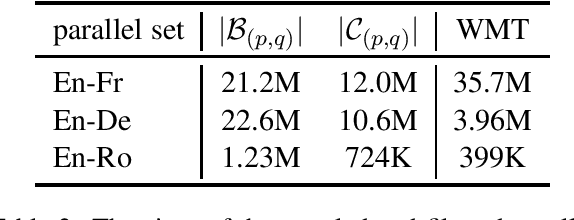
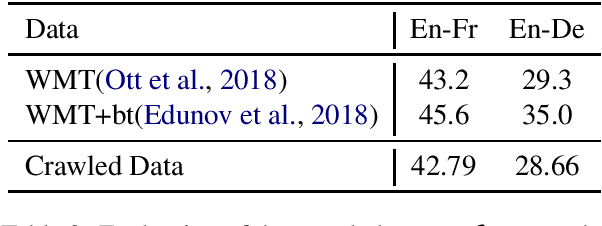

Abstract:With a large amount of parallel data, neural machine translation systems are able to deliver human-level performance for sentence-level translation. However, it is costly to label a large amount of parallel data by humans. In contrast, there is a large-scale of parallel corpus created by humans on the Internet. The major difficulty to utilize them is how to filter them out from the noise website environments. Current parallel data mining methods all require labeled parallel data as the training source. In this paper, we present a pipeline to mine the parallel corpus from the Internet in an unsupervised manner. On the widely used WMT'14 English-French and WMT'16 English-German benchmarks, the machine translator trained with the data extracted by our pipeline achieves very close performance to the supervised results. On the WMT'16 English-Romanian and Romanian-English benchmarks, our system produces new state-of-the-art results, 39.81 and 38.95 BLEU scores, even compared with supervised approaches.
Funnel-Transformer: Filtering out Sequential Redundancy for Efficient Language Processing
Jun 05, 2020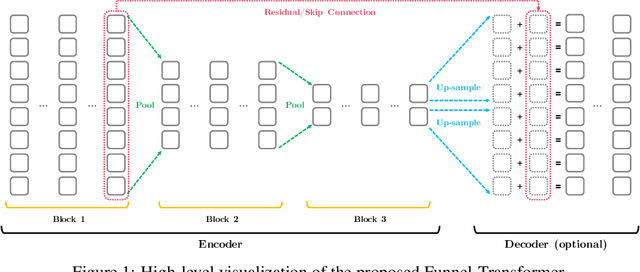
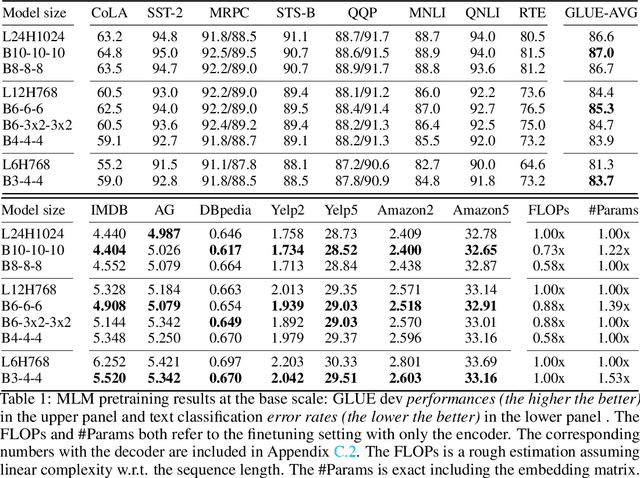
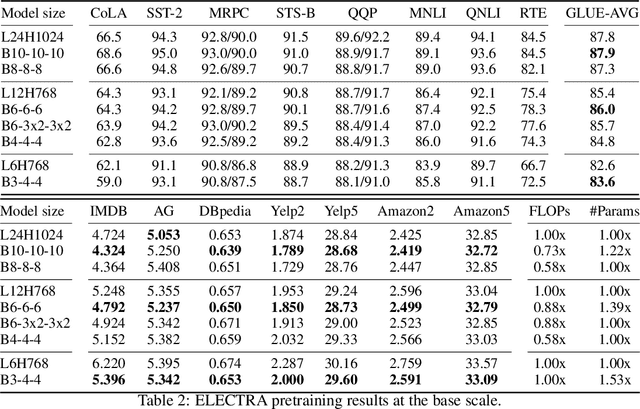
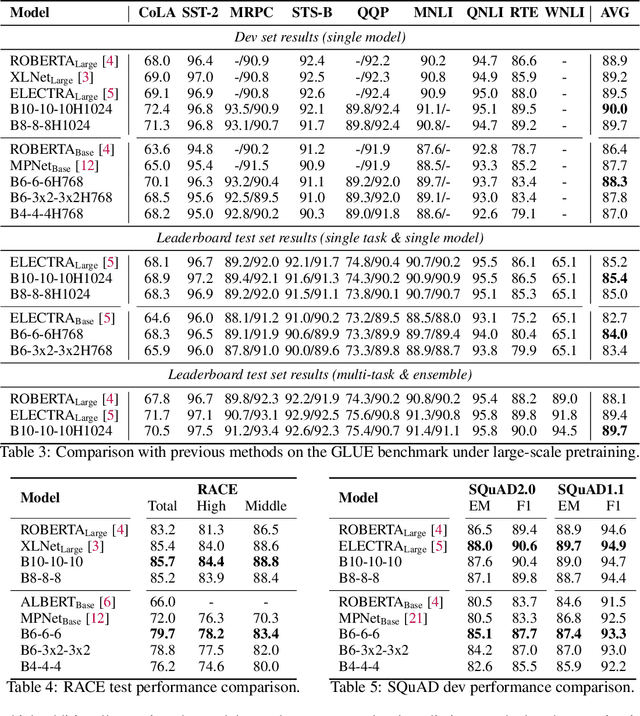
Abstract:With the success of language pretraining, it is highly desirable to develop more efficient architectures of good scalability that can exploit the abundant unlabeled data at a lower cost. To improve the efficiency, we examine the much-overlooked redundancy in maintaining a full-length token-level presentation, especially for tasks that only require a single-vector presentation of the sequence. With this intuition, we propose Funnel-Transformer which gradually compresses the sequence of hidden states to a shorter one and hence reduces the computation cost. More importantly, by re-investing the saved FLOPs from length reduction in constructing a deeper or wider model, we further improve the model capacity. In addition, to perform token-level predictions as required by common pretraining objectives, Funnel-Transformer is able to recover a deep representation for each token from the reduced hidden sequence via a decoder. Empirically, with comparable or fewer FLOPs, Funnel-Transformer outperforms the standard Transformer on a wide variety of sequence-level prediction tasks, including text classification, language understanding, and reading comprehension. The code and pretrained checkpoints are available at https://github.com/laiguokun/Funnel-Transformer.
Explainable Unsupervised Change-point Detection via Graph Neural Networks
Apr 24, 2020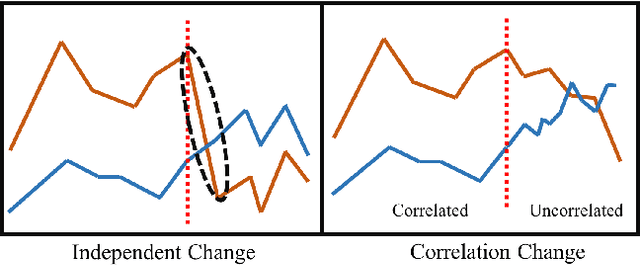



Abstract:Change-point detection (CPD) aims at detecting the abrupt property changes lying behind time series data. The property changes in a multivariate time series often result from highly entangled reasons, ranging from independent changes of variables to correlation changes between variables. Learning to uncover the reasons behind the changes in an unsupervised setting is a new and challenging task. Previous CPD methods usually detect change-points by a divergence estimation of statistical features, without delving into the reasons behind the detected changes. In this paper, we propose a correlation-aware dynamics model which separately predicts the correlation change and independent change by incorporating graph neural networks into the encoder-decoder framework. Through experiments on synthetic and real-world datasets, we demonstrate the enhanced performance of our model on the CPD tasks as well as its ability to interpret the nature and degree of the predicted changes.
Bridging the domain gap in cross-lingual document classification
Sep 20, 2019



Abstract:The scarcity of labeled training data often prohibits the internationalization of NLP models to multiple languages. Recent developments in cross-lingual understanding (XLU) has made progress in this area, trying to bridge the language barrier using language universal representations. However, even if the language problem was resolved, models trained in one language would not transfer to another language perfectly due to the natural domain drift across languages and cultures. We consider the setting of semi-supervised cross-lingual understanding, where labeled data is available in a source language (English), but only unlabeled data is available in the target language. We combine state-of-the-art cross-lingual methods with recently proposed methods for weakly supervised learning such as unsupervised pre-training and unsupervised data augmentation to simultaneously close both the language gap and the domain gap in XLU. We show that addressing the domain gap is crucial. We improve over strong baselines and achieve a new state-of-the-art for cross-lingual document classification.
 Add to Chrome
Add to Chrome Add to Firefox
Add to Firefox Add to Edge
Add to Edge